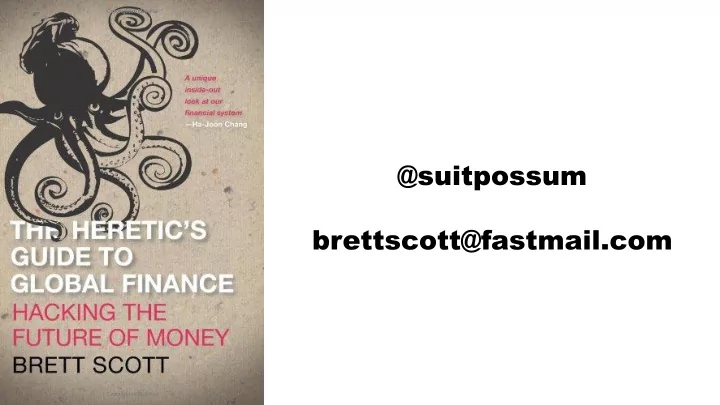

@suitpossum brettscott@fastmail.com
The Future… accor ccording to Finte ding to Fintech
Finte Fintech h 1: 1: Auto utoma mate the te the use user-exp xper erien ience ce lay layer er
Finte Fintech h 1: 1: Auto utoma mate the te the use user-exp xper erien ience ce lay layer er
Finte Fintech h 1: 1: Auto utoma mate the te the use user-exp xper erien ience ce lay layer er … or add new layers on top
Fin Finte tech h 2: 2: Aut utom omate te finan financia cial l pr prof ofes ession sionals als
Fint Fintec ech h 3: 3: Fu Fuse se it it all all with with IoT IoT (non (non-hu human man age gent nts) s)
The he INTERNE INTERNET T OF OF FUL FULLY Y AUT UTOMA OMATE TED D CA CAPIT PITAL ALISM ISM Aut utoma omation tion of of la labo bour ur + + Aut utoma omation tion of of ma mana nage gemen ment t + + Aut utoma omation tion of of e excha hang nge
A note on hacker culture & the drive to re-decentralise or re- humanise digital infrastructures
Open Public Blockchain 1.0 A means for an open network of strangers to keep track of their positions relative to each other, without a (clearly identifiable) central intermediary, Players (theoretically) possess equal rights in the system
What does decentralisation actually mean?
Open Public Blockchain 2.0 A means for an open network of strangers to keep track of their positions relative to each other, and to automate certain interactions with each other ( ‘smart - contracts’) without a (clearly identifiable) central intermediary Players (theoretically) possess equal rights in the system
Bank Banks an s and op d open en cr crypto yptocu curren ency y syste systems ms
A digital information recording, management, coordination and contracting architecture Limited ‘fusion’ into the material world unless via 1) legal system or 2) Internet of Things integration
Closed Private Blockchains A means for a closed network of (loosely) associated parties to keep track of their positions relative to each other, and to automate certain interactions with each other, by coming together under a mutually agreed shared infrastructure rather than relying on finding ways to make their separate infrastructures interact. Potential for different or unequal rights in the system
Reducing the vision to
Fin Finte tech h 4: 4: Aut utoma omate te co co-or ordin dinatio tion n for or efficiency & cost- saving (profit optimisation)
Open blockchain governance
Initial ‘legislation’: A pioneer group of developers propose & (collaboratively) develop an initial protocol
‘Executive branch’: The protocol is a set of rules – a hard- coded ‘bureaucracy’ – but it relies upon validators (e.g. miners) to activate it. Similarities with a ‘civil service’ who maintain the execution of the system
‘Citizens’: Non -expert users then use this infrastructure. While it might be very useful and empowering to them, they have little say in running it
‘Judiciary’ and arbitration? ‘Mathematical law’ thought impossible to break + very few initial processes for resolving disputes, or no processes
Subsequent ‘legislation’ 1: Old developers and newer developers then propose changes, using informal processes to debate, collaborate or compete
Subsequent ‘legislation’ 2: Large and small validators can act as a type of ‘technocratic parliament’, who can choose to go along with changes, or reject them. Larger players arguably have a ‘veto’ power
Some formalised institutions appear to mediate in this, or influence the process, but no initial written constitution that sets out powers of different parties. ‘Constitution’ is informal and established by precedent and convenience. Certain formal institutions can emerge for proposing changes
Hard-coded protocol maintained by an (uncoordinated) executive, combined with a lack of clear legislation processes results in the primary political option for users being ‘exit’: If you don’t like it you can leave
This is fine if leaving is actually a meaningful option (or if you have skills to fork the open source code), but in the context of network effects (lock-in) you risk creating user groups with no voice, dependent on a platform they have little say in. This is not unique to blockchain – we find this in centralised platforms like Uber etc.
Existing blockchain community often implicitly endorse two approaches to blockchain governance: either very rigid codified ‘civil law’ (‘incorruptible’), or a more malleable yet technocratic ‘common law’ (‘flexible’). Exemplified in the Ethereum fork debate: Ethereum Classic represents the former, and Ethereum – arguably – represents the latter
@suitpossum brettscott@fastmail.com
Recommend
More recommend